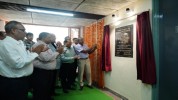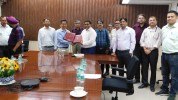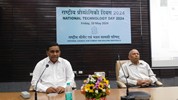


News & Events

News & Events
- Advertisement No. C/08/2024(02) - Written Test/Personal Discussion (11th Nov 2024) - POSTPONED
- NCB IC Event: Innovate Youth: Building Tomorrow's Entrepreneurs.
- PG Diploma Admission 2024-25 - Written Test & Interview Reg.-Round II
- List of selected candidates for admission to One Year Post Graduate Diploma in Cement Technology at NCB Ballabgarh for Session 2024-25
Consultancy services for getting NABL Accreditation as per ISO/IEC 17025:2017
Notice on Public Grievance
NCB – CCE EVENTS / Forthcoming Training Programmes
Ongoing Proficiency Testing Schemes
ONLINE Payment Facility
Steps for Online Payment through SB Collect
Last date for Submission of Technical Papers in 18th NCB International Conference & Exhibition extended to 31st August 2024
Last date for applying for National Awards in Indian Cement Industry 2022-24 is extended to 31st August 2024
Post Graduate Diploma in Cement Technology 2024-25 (Date Extended upto 15 July 2024)
NCB requires Lab Analysts, Junior Assistants, Senior Assistant and Designer on Direct Recruitment Basis
New Facilities added in Calibration Services
18th NCB International Conference - Call for Papers
Corrigendum - Compassionate Appointment in NCB for Group “C” & “D
Compassionate Appointment in NCB for Group “C” & “D
18th NCB International Conference, 27-29 Nov 2024 (Bulletin 1)
NCCBM to host 17th International Congress on Chemistry of Cement (ICCC) in 2027 in New Delhi
Standard Project Proposals
Limestone Consumption Factor (LCF)
Scope of work:
- Evaluation of plant data in respect of raw materials characteristics, raw mix design, fuel, clinker quality and dust losses etc.
- Characterization of representative samples of raw materials, raw meal, kiln feed, clinker, coal and dust collected during plant visit.
- Determination of kiln feed to clinker ratio.
- Establishing limestone consumption factor
- Preparation of report based on the above
Geological classification of raw materials and additives will not form a part of LCF studies and any nomenclature declared by national or international agencies/sources (such as IBM) will be used.
Evaluation of Raw Materials and Cement
Scope of work:
Evaluation of the following samples to be carried out on quarterly basis.
| Sl.No | Nature of test | Type of samples | Parameters determined |
| 1. | Chemical analysis | Limestone | LOI, CaO, SiO2, Al2O3, Fe2O3, SO3, MgO, Na2O, K2O, TiO2, P2O5, Mn2O3, Cl, free silica |
| Additives | LOI, CaO, SiO2, Al2O3, Fe2O3, SO3, MgO, Na2O, K2O, TiO2, P2O5, Mn2O3,, Cl | ||
| Industrial wastes | LOI, CaO, SiO2, Al2O3, Fe2O3, SO3, MgO, Na2O, K2O, TiO2, P2O5, Mn2O3, Cl, F, Cl, reactive silica (for fly ash/pozzolana), Sulphide sulphur (for Slag)
Heavy & toxic elements by ICP |
||
| Raw meal and kiln feed | LOI, CaO, SiO2, Al2O3, Fe2O3, SO3, MgO, Na2O, K2O, TiO2, P2O5, Mn2O3, Cl, free silica | ||
| Coal/pet coke | Proximate analysis, Ultimate analysis, Calorific value, Hard Groove Index | ||
| Clinker, OPC, PPC, PSC and any other type of cement | LOI, CaO, SiO2, Al2O3, Fe2O3, SO3, MgO, Na2O, K2O, TiO2, P2O5, Mn2O3, Cl, free lime, insoluble residue etc | ||
| Coatings, build-ups etc | LOI, CaO, SiO2, Al2O3, Fe2O3, SO3, MgO, Na2O, K2O, TiO2, P2O5, Mn2O3, Cl, | ||
| 2. | Physical testing | Limestone, clinker | Bond Grindability Index, Litre weight (for clinker) |
| Fly ash | All parameters as per Indian Standard | ||
| OPC, PPC & PSC | Complete physical testing as per relevant Indian Standard | ||
| Kiln feed, OPC, PPC & PSC | Particle size distribution (PSD) | ||
| 3. | Mineral/phase analysis by XRD | Limestone and raw materials | Mineral phase analysis of raw materials, detection of pyrites and other minor phases after removing carbonates, |
| Clinker & OPC | Semi-quantitative estimation of cement phases, polymorphism, detection of free lime, periclase or any other undesired phases, alkali sulphates / chlorides etc. | ||
| Rings/coatings/build-ups etc (if any) | Phase analysis | ||
| 4. | Microscopic analysis | OPC clinker | Microstructure and granulometery |
| 5. | Compilation of test data and reporting | ||
- Terms & conditions: 1. Samples lot to be provided quarterly by the plant at the beginning of respective quarter (No. of samples in each quarter ≤15)
- Report will be submitted within 30-45 days after receipt of sample/ R&D contribution which ever is later.
Optimization of Raw Mix Design for Manufacture of Cement
Scope of work:
- Site visit, discussions with plant management, collection of relevant data and representative samples of raw materials and fuel.
- Physico-chemical and mineralogical evaluation of raw materials and fuel.
- Designing and preparation of different raw mixes utilizing limestone and other raw materials.
- Burnability studies of above raw mixes and evaluation of free lime content in the laboratory clinker samples.
- Mineralogical and micro structural evaluation of above clinker samples using X-ray diffraction and Optical Microscopic techniques.
- Optimization of raw mix design
- Bulk preparation of optimized laboratory clinker sample.
- Preparation of cement sample from above laboratory clinker.
- Performance evaluation of above cement sample as per relevant Indian Standard Specification.
- Report covering 1-9 above.
Utilization of Low-Grade Limestone in Manufacture of Belite Cement Targeting the Strength Requirements of OPC-43 grade Cement
Scope of work:
- Plant visit, discussions with plant management, collection of relevant plant data and representative samples of raw materials, clinker and fuel.
- Physico-chemical and mineralogical evaluation of raw materials, clinker and fuel.
- Designing and preparation of different raw mixes utilizing available low-grade limestone along with mineralizer / sweetener.
- Burnability studies of above raw mixes and evaluation of free lime content in clinker samples.
- Mineralogical and microstructural evaluation of above clinker samples using XRD and OM techniques, bond grindability index and litre weight of clinker sample thus prepared.
- Optimization of raw mix, burning conditions and preparation of laboratory clinker from the optimized raw mix
- Bulk preparation of optimized laboratory clinker sample.
- Preparation of cement sample from above clinker and its performance evaluation as per Indian Standard Specification.
- Establishing Techno-Economic viability of the product.
- Preparation of report covering 1-9 above.
Optimization of Raw Mix Design for Manufacture of OPC (Green Field Project)
Scope of work:
- Site visit, discussions with plant management and collection of relevant data and representative samples of raw materials and fuel
- Chemical analysis of raw materials and additives for the following constituents: Total carbonates, CaCO3, MgCO3, LOI, CaO, SiO2, Al2O3, Fe2O3, MgO, SO3, Na2O, K2O, Mn2O3, P2O5, Chloroide, free silica etc
- Mineralogical and microstructural evaluation of above materials by X-ray diffractometery and Optical microscopy
- Thermal analysis to determine decarbonation characteristics of limestone
- Bond grindability, hardness on mho’s scale, aggregate abrasion by Los angels test and aggregate impact value test of limestone sample(s)
- Proximate analysis, ultimate analysis and coal ash analysis and hard groove index of fuel sample(s)
- Designing of raw mixes using above raw materials and fuel at defined moduli values and fineness level in order to obtain desired quality of OPC clinker
- Burnability studies on the above designed raw mixes
- Mineralogical evaluation of clinkers prepared from above raw mixes by X-ray diffractometery and optical microscopy
- Optimization of raw mix on the basis of 8-9 above
- Preparation of bulk clinker in a laboratory furnace from optimized raw mix and its evaluation by X-ray diffraction and optical microscopy
- Bond grindability of bulk clinker
- Preparation of OPC from bulk clinker and its performance evaluation as per relevant Indian Standard Specification.
- Report covering 1-13 above.
Investigations on Performance Improver in Cement
Scope of work:
- Physico-chemical and mineralogical characterization of the samples of limestone, blast furnace slag, fly ash, rice husk ash, metakaoline, clinker and mineral gypsum.
- Preparation of control OPC and OPC blends by inter-grinding using 5 percent each of limestone, blast furnace slag, fly ash, rice husk ash, metakaoline samples with OPC clinker and mineral gypsum keeping constant Blaine’s fineness.
- Particle size gradation of above cement samples.
- Performance evaluation of above cement samples at ages of 3, 7 and 28 days for mortar strength under standard testing conditions.
- Report covering 1-4 above.
Maximization of Fly ash in PPC with Improving Clinker Quality
Scope of work:
- Plant visit by NCB team for discussions with the plant management and collection of representative samples of limestone, additives, fuel, in-process materials, gypsum and fly ash.
- Physical, chemical and mineralogical characterization and evaluation of above samples.
- Designing of raw mixes using above raw materials and fuel for the manufacture of Portland cement clinker with target C3S content.
- Burnability studies on the above designed raw mixes.
- Mineralogical evaluation of clinkers prepared from above raw mixes by optical microscopy and X-ray diffraction analysis.
- Optimization of raw mix on the basis of 4 and 5 above.
- Preparation of bulk clinker in a laboratory furnace from optimized raw mix at (6) above and its evaluation by optical microscopy and X-ray diffraction analysis.
- Preparation of PPC of target fineness from above (7) bulk clinker using target percentage of fly ash and its performance evaluation as per relevant Indian Standard Specification.
- Report covering 1-8 above.
Utilization of Blast Furnace Slag in the Manufacture of Portland Slag Cement (PSC)
Scope of work:
- Plant visit by NCB team for discussion with the plant management and providing guidelines for collection of representative samples of blast furnace slag.
- Characterization of above blast furnace slag samples collected for establishing quality and quality variation and preparation of a composite sample of blast furnace slag.
- Physico-chemical and mineralogical characterization of samples of composite blast furnace slag, clinker and mineral gypsum.
- Preparation of various PSC blends using different blend ratio of composite sample of blast furnace slag, clinker and gypsum at a fixed fineness level.
- Performance evaluation of above PSC blends and optimization of blend composition i.e. clinker-slag ratio.
- Preparation of PSC blends with optimized blend composition at different fineness levels.
- Performance evaluation of blends prepared at 6 above and optimization of fineness level.
- Preparations of Portland Slag Cement blend with optimized blend composition at optimized fineness and its performance evaluation for its conformity to Indian Standard Specification IS: 455-1989.
- Report covering 1-8 above.
Investigations on the Causes of Lump Formation in Cement Bags
Scope of work:
- Plant visit for on the spot assessment of grinding and storage conditions, extent of lump formation and collection of relevant samples including cement lumps and plant data.
- Chemico-mineralogical evaluation of raw materials, clinker, gypsum, cement and cement lumps.
- Identification and evaluation of various factors leading to lump formation in the cement bags.
- Optimization of type (gypsum / natural anhydrite/ hemi hydrate) and content of SO3 for reducing lump formation in the cement bags.
- Optimization of grinding process parameters to reduce / eliminate lump formation in the cement bags.
- Formulation of recommendations for preventing/eliminating lump formation in the cement silo.
- Preparation of report covering 1-6 above.
Diagnostic Studies on the Causes of Coating and Build ups in Cement Rotary Kiln System
Scope of work:
- Visit of NCB team for on the spot assessment of the problem during normal operation as well as physical inspection of coating and build ups during kiln shut down.
- Collection of relevant samples of used / unused refractory, coating and buildup samples, raw materials, in-process materials, fuels, process water, etc.
- Collection of specific process and quality control data as per questionnaire specifically prepared for the study.
- Assessment of existing kiln operating parameters and process measurements related to CO/O2 levels, shell temperatures, etc.
- Interim report based on preliminary findings during plant visit, pending detailed investigations.
- Physico-chemical, thermal and mineralogical characterization of samples as collected above at NCB labs.
- Evaluation and interpretation of the data as obtained above and from the results of NCB lab investigations.
- Establishing the causes of coating and buildup formation and formulation of recommendations for reducing / minimizing the occurrence of coating and buildups.
- Preparation of report covering 1-8 above.
Diagnostic studies on the causes of Kiln Shell Corrosion in Cement Rotary Kiln System
Scope of work:
- Visit of NCB team for on the spot assessment of the problem during normal operation as well as physical inspection of corroded kiln shell during kiln shut down.
- Collection of relevant samples of used / unused refractory, corroded kiln shell flakes, raw materials, in-process materials, fuels, water, etc.
- Assessment of existing kiln operating parameters.
- Interim report based on preliminary findings during plant visit, pending detailed investigations.
- Characterization of samples as collected above by physical, chemical and mineralogical methods at NCB lab.
- Evaluation and interpretation of the data obtained above and from the results of NCB lab investigations.
- Establishing the causes of kiln shell corrosion and formulation of recommendations for remedial measures.
- Preparation of report covering 1-7 above.
Diagnostic Investigations on Premature failure of Refractories in the Cement Rotary Kiln
Scope of work:
- Plant visit of NCB experts for on the spot assessment of the problem and collection of relevant samples of used/ unused refractories, raw materials, in-process materials, fuel and product.
- Collection of relevant data on refractory quality and laying practices, heating schedule, mix quality, kiln operation, burner location and fuel combustion, etc.
- Physico-chemical, thermal and mineralogical characterization and evaluation of above samples.
- Evaluation of data collected and establishing the causes of premature refractory failure.
- Formulations of the recommendations for improving the performance of refractory lining in the rotary kiln.
- Preparation of report covering 1-5 above.
Investigations on Used Refractory Brick Samples
Scope of work:
- Physico-chemical and thermo-mineralogical evaluation of damaged refractory bricks as provided by sponsor
- Interpretation of Results as obtained from above
- Establishing extent of damage in refractory bricks and identifying the reasons for the damage.
- Preparation of report covering 1-3 above.
Refractory Management Studies in the Cement Rotary Kiln System
Scope of work:
- Plant visit for collection of samples of area wise used / unused refractories, in process materials, fuels, etc. and assessment and collection of data on following:
- Refrectory lining design, layout, quality, brick shapes, size, combination and expansion allowance etc.
- Refractory laying practices.
- Anchor design and spacing configuration
- Heating and cooling schedules.
- Kiln operating parameters.
- Raw mix design, fuel quality, product, coating, build-ups and rings characteristics (if applicable).
- Kiln mechanics-ovality/ alignments
- Statistical refractory performance.
- Burner design, its placement in kiln and related aspects.
- Evaluation of the data obtained from the above
- Establishing the physico-chemical and mineralogical compatibility of the refractory products with kiln operation, raw mix and product quality.
- Establishing the wear rate and refractory consumption factor.
- Design of techno-economic lining schemes for CRK system.
- Formulations of guidelines for refractory management system.
- Preparation of report covering 1-15 above.
Diagnostic Investigations on Premature Refractory Failures of Burner Pipe of Cement Rotary Kiln
Scope of work:
- Plant visit of NCB team for on the spot assessment of the problem.
- Collection of relevant samples of worn out refractory of burner pipe and other in-process materials, etc. and prevailing installation/ heat up procedures being followed at the plant.
- Collection of kiln operating data and assessment of plant operating conditions
- Characterization of the above samples by physical, chemical, thermal, mineralogical and microscopic techniques
- Establishing the causes of the refractory failures and formulating recommendations for remedial measures for improving the lining life of burner pipe refractories.
- Preparation of report covering 1-5 above.








